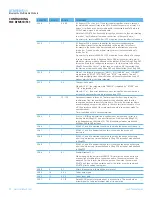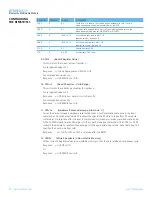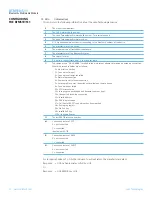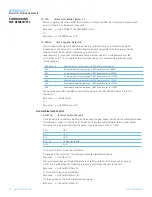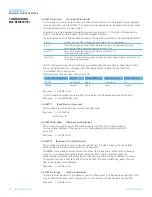
19
www.lairdtech.com
Laird Technologies
BTM510/511
Bluetooth
®
Multimedia Module
CONFIgurINg
THE BTM510/511
REGISTER
DEFAULT
RANGE
COMMENT
S554
0
0..900
If S Register 512>=2 and <=7 then this register specifies a time in seconds
for which the device will stay in the S512 mode after power up or reset. On
timeout, it will abort the discoverable and/or connectable and fall back into
S512=1 mode, when it is deaf and dumb.
Note that if AT+BTR has been used to specify a peer device, then on reverting
to mode 1, it will attempt to make a connection to that peer device.
A power cycle, reset via BREAK or ATZ is required to see the effects of change.
S555
1
1..7
If S Register 554 is nonzero, then after the post reset window expires,
the mode will revert to the mode specified in this register. This allows,
for example, the device to be discoverable and connectable on power up
(mode 4 or 7) and on window timer expiry to revert to connectable only
(mode 3 or 6).
A power cycle, reset via BREAK or ATZ is required to see effects of a change.
In some firmware builds, S Registers 565 to 569 inclusive are visible, which
allows the start-up mode to depend on the state of RI line (Setting S Reg 565
forces the RI pin to be configured as an input). For this feature to be active,
SReg 565 should be set to 1. In that case, on start-up, if RI is asserted, then
the start-up mode is defined by S Reg 568 and if deasserted then S Reg 569.
S558
0
0..1
When 1, the following responses; “RING”, “NO CARRIER” and “CONNECT”
are replaced by “BTIN”, “BTDOWN” and “BTUP” respectively. This will
eliminate ambiguity when the module has a Bluetooth connection to an AT
modem which also gives these responses.
S559
0
0..3
This specifies a mask.
When Bit 0 is 1, the response word “ERROR“ is replaced by “BTERR” and
“OK” is replaced by “ok”.
When Bit 1 is 1, then error responses do not include the error number and
instead the error number can be retrieved using ATI12.
S560
15
15..120
Disconnect timeout in seconds. This timer specifies how long to wait for
confirmation from the peer device and/or the underlying stack that the
connection has been successfully torn down. There can be instances where
a confirmation does not arrive and so in this case this timer is used to ‘close
off’ the procedure and put the state machine back into a proper mode for
new operations.
Time is specified with 15 seconds intervals.
S565
0
1
If set to 1, RI (Ring Indicate) line is configured as an input and forces the
start-up mode (SReg512) and post-timeout on Start-up mode (SReg555)
to be dependent on the state of RI. The RI conditional modes are defined
by SRegs 566 to 569 inclusive.
S566
1
7
If S565=1, and RI is asserted then this is the mode the device will start up in.
S567
1
7
If S565=1, and RI is deasserted then this is the mode the device will
start up in.
S568
1
7
If S565=1, and RI is asserted then this is the mode the device will assume
after the post-start-up timeout defined in SReg 554 instead of mode defined
in SReg555
S569
1
7
If S565=1, and RI is deasserted then this is the mode the device will assume
after the post-start-up timeout defined in SReg 554 instead of mode defined
in SReg555
S584
0
0..1
Enable/Disable eSCO
When changing the unit returns ERROR 14 it implies the device is either in
a connection or waiting for a connection and so the new value cannot be
accepted. For the former, drop the connection, then issue the command
AT+BTX and then set the new value and for the latter issue the command
AT+BTX prior to setting the register.
S588
0
0..1
After a disconnection, there will be a cold reset
S589
15
0..22
Codec output gain
S590
15
0..22
Codec input gain
S591
0
0..1FF
Default GPIO output states when not in a connection. This is used when
virtual digital i/o cable replacement mode is in operation















